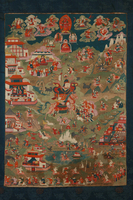
The category of Mahasiddha (Indian Adept) is a large subject in both Himalayan and Tibetan art as well as for the entire subject of Vajrayana Buddhism. There are two common lists of the Eighty-four Mahasiddhas and several less common compilations that appear both in literature and art. The two most common systems found in both art and literature are the Abhayadatta and the Vajrasana, both named after the authors of the lists.
The most important topic to understand first in the study of Indian Tantric siddhas is the definition of the term mahasiddha. Firstly, it is a term that designates a level of attainment within Vajrayana Buddhism. Secondly it refers, in Tibetan art, to a certain kind of appearance following after the model of a Heruka deity (Hevajra, Chakrasamvara, etc.) according to the 'Sarma' Traditions of Tibetan Buddhism. In the art of painting and sculpture those individuals designated with the attainment of the level of a mahasiddha can have one of three general forms or depictions, [1] monastic, [2] layperson, or [3] siddha appearance - modeled after a semi-wrathful or wrathful Tantric deity. Most mahasiddhas do not have siddha appearance.
Amongst all of these different sets and groups of siddhas only a small percentage of siddhas are consistently identifiable iconographically over time and outside of the context of the individual sets of eighty-four. There are also several lists and sets of Eight Great Mahasiddhas which are derived from the two common lists of the Eighty-four Mahasiddhas.
Although there are only a small number of siddhas that are identifiable consistently over time many more of the siddhas can be identified when appearing in sets of paintings or sculpture that depict the entire group of the Abhayadatta or Vajrasana figures. With painting sets it becomes even easier when there are inscriptions and labels accompanying each figure. It is even easier when paintings depicting multiple siddhas from a larger set of compositions are compared with other painting sets from the same chronological period or period relatively close in time, style or possibly region of the Himalayas or Tibet.
Easy to Identify Indian Mahasiddhas:
- Saraha, holding an arrow
- Shavaripa, holding a bow
- Virupa, the arm raised upward with a pointing finger
- Dombhi Heruka, riding a tiger
- Luipa, eating fish entrails
- Tilopa, holding a fish
- Damarupa, holding a double-sided drum
- Nagarjuna, with snakes hovering above the head
- Shantideva, a monk floating in the air
- Jalandhara, the leg raised above the head
- Shridhara, having a buffalo head
- Ghantapa, holding a vajra and bell, in a flying posture
- Krishnacharin, surrounded by drums and umbrellas
- Avadhutipa, with the right hand index finger pointed over the knee
- Vinapa, holding a lute
- Atisha, a monk with a stupa and round back to the right and left
- Possibly others....
 Easy to Identify Tibetan Teachers:
Easy to Identify Tibetan Teachers:
Within the context of Tibetan teachers with easy to identify mahasiddha, mahasiddha-like, or yogi appearance there are the figures of:
- Shri Simha
- Padmasambhava
- Milarepa
- Tsongkhapa (in siddha form)
- Tangtong Gyalpo
- Tsang Nyon Heruka
- Do Khyentse Yeshe Dorje (siddha form)
- Jamyang Khyentse Wangpo (siddha form)
- Khyentse Chokyi Lodro (siddha form)
- Possibly others....
The form of the wrathful protector deity known as Brahmanarupa Mahakala is commonly mistaken for an India mahasiddha - in siddha appearance.

















